Rubber Roof Repairs
EPDM, a cost-effective roofing system widely used in Pennsylvania’s commercial buildings, is commonly overlooked as a rubber roof by business owners and facility managers. Ethylene propylene diene terpolymer (EPDM) is a resilient synthetic rubber membrane designed for flat or low-slope roofs in commercial settings. Despite its impressive durability and lifespan of over 30 years, EPDM rubber roofs are particularly vulnerable to damage in Pennsylvania’s harsh climate. As a result, these roofs frequently experience leaks, needing rubber roof repairs much earlier than should be necessary.
Weather and Environmental Impacts on Rubber Roofs
Rubber roofs are significantly influenced by weather and environmental conditions. Without the safeguard of an acrylic elastomeric reflective coating, the relentless heat from the sun’s harmful UV rays can lead to the contraction, brittleness, and cracking of the rubber membrane. Consequently, the roofing system becomes vulnerable to water leaks during rainfall. Inadequately executed rubber roof repairs can jeopardize the entire roofing system, ultimately necessitating untimely replacement.
Rubber Roof Coatings
Lester’s Carpentry, an authorized Conklin Roofing Systems contractor, specializes in Pennsylvania’s EPDM rubber roof repairs for agricultural, industrial, and commercial buildings that are older or weathered. Our elastomeric roof repair coatings offer a resilient, budget-friendly, and energy-efficient option as an alternative to complete rubber roof replacement.
Eliminating Future Roof Replacements: Sustainable & Renewable Solution
By utilizing Conklin’s single-ply rubber membrane coatings, you can achieve a sustainable and renewable approach to repairing and safeguarding your current EPDM rubber roof. This innovative system not only restores and protects the roof but also establishes a resilient waterproof barrier, effectively preventing future leaks that could necessitate roof replacements. With periodic re-coating, your rubber roof’s lifespan can be extended for decades. Moreover, this process can often be repeated multiple times throughout its useful life, maximizing the value of your roofing investment.
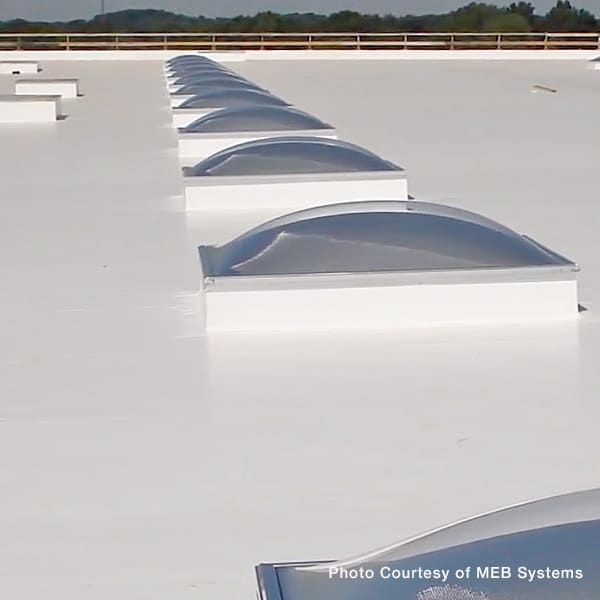
5 Advantages Offered by Rubber Roof Repairs
Improve and safeguard your current rubber roof with our white solar-reflective coatings for rubber roof repairs. These coatings provide a 100% seamless, walkable, water- and fire-resistant surface that surpasses many other roofing materials in terms of cost-effectiveness, durability, and energy efficiency. In addition to these remarkable features, they offer a range of exceptional benefits:
1. Fast Roof Leak Repair
Our white reflective coatings for rubber roof repairs provide a durable and cost-effective solution for restoring aging or weathered EPDM membranes. These coatings extend the lifespan of your roof by several decades, helping you avoid costly roof replacements. By reflecting sunlight, this repair solution also creates a “cool roof” effect, reducing heat absorption and keeping the building cooler. This not only boosts the roof’s longevity but also delivers a lower energy bill over time, making it a smart, economical choice for facility management. Regular rubber roof repairs keep your roof in optimal condition, preventing minor leaks from becoming major problems.
2. Superior Weatherproof Barrier
Enjoy peace of mind with a high-quality waterproof barrier that protects your rubber roof membrane 24/7. Our coatings shield against the harshest weather elements, including rain, wind, and intense UV rays, which are some of the primary causes of roofing deterioration. This protective layer helps maintain the membrane’s integrity and flexibility, reducing wear and tear from frequent weather exposure. With this advanced level of weatherproofing, your rubber roof stays in top shape, which means fewer repairs and maintenance costs over time. Timely rubber roof repairs help prevent water penetration, ensuring a dry, well-protected building interior.
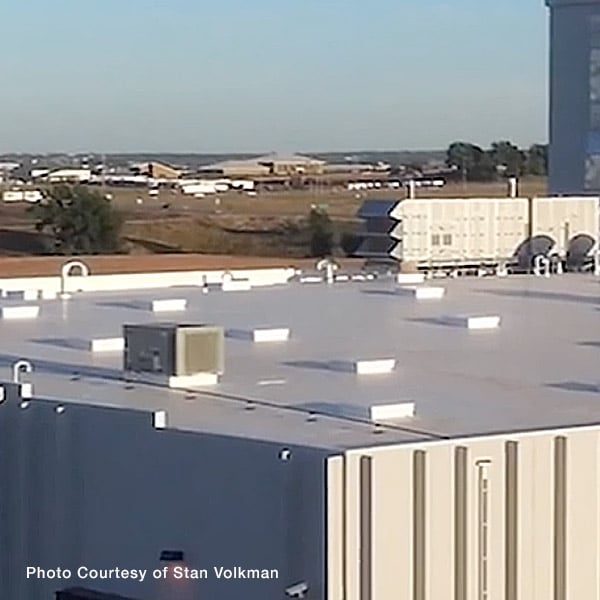
3. Saves Energy Costs
Our coatings for rubber roof repairs are EnergyStar and Cool Roof Rating Council (CRRC) certified, demonstrating their high energy efficiency. These coatings reflect up to 85% of the sun’s UV radiation, which lowers the roof’s surface temperature by as much as 80°F. This cooling effect can lead to significant energy savings by reducing the need for constant air conditioning.
Not only does this reduce operational costs, but it also supports sustainability goals by lowering the building’s overall carbon footprint. By applying these coatings, your rubber roof repairs not only keep your building cooler but also contribute to a greener environment. This energy-efficient solution helps businesses reduce their reliance on HVAC systems, providing long-term savings on energy bills and reducing the environmental impact.
4. Positive Return on Investment
Our rubber roof repairs provide energy savings that often cover the repair costs themselves within a short period. The energy savings from the reflective coatings reduce cooling costs, making the initial investment worthwhile. Additionally, you may qualify for tax credits, utility rebates, and other financial incentives, further enhancing the return on investment.
These cost-saving benefits allow you to quickly recoup the money spent on roof repairs. By choosing this repair option, your business not only enjoys a more efficient roof but also gains financial advantages. With reduced operational costs and the potential for additional incentives, investing in rubber roof repairs adds value and long-term savings to your roofing investment, making it a financially smart choice.
5. Extends Your Rubber Roofing System’s Lifespan
Our white reflective rubber roofing repair coatings offer a long-lasting, cost-effective solution for extending the life of aging or weathered EPDM membranes. With this roof restoration, you can add decades to the roof’s lifespan without the expense and disruption of a full replacement. This coating provides the advantages of a “cool roof” by reflecting heat, improving energy efficiency while preserving the structural integrity of the roof. It’s an ideal choice for facilities seeking a sustainable and budget-friendly roof upgrade.
Rubber Roof Repairs in Pennsylvania
Why replace when you can repair and preserve your rubber roof in Pennsylvania for less? For a limited time, Lester’s Carpentry is offering FREE roof inspections for agricultural, industrial, and commercial buildings in Rossiter, Greensburg, Clarion, Ridgway, and surrounding communities in Pennsylvania. Call to schedule an appointment for a free estimate today.
7 Most Common FAQs For Rubber Roof Repairs
1. How long does a rubber roof last with proper maintenance?
With proper care and regular maintenance, a rubber roof can last 20-30 years or more. Regular inspections, repairs, and protective coatings can significantly extend the roof’s life. Keeping the roof free from debris, promptly addressing small issues, and applying UV-resistant coatings all contribute to long-term durability. Clients often find that investing in maintenance early on helps prevent costly replacements, allowing the rubber roof to offer dependable protection for many years.
2. Is a rubber roof environmentally friendly?
Yes, rubber roofs are considered environmentally friendly due to their longevity, recyclability, and energy-saving properties. EPDM material can often be recycled at the end of its life, reducing waste. Rubber roofs with reflective coatings can also improve energy efficiency by lowering indoor cooling needs. By choosing rubber roofing and maintaining it properly, clients can reduce their environmental impact and enjoy a durable, sustainable roofing option.
3. What are the main benefits of choosing a rubber roof?
Rubber roofs offer several key benefits, including durability, weather resistance, flexibility, and low maintenance needs. They resist cracking in extreme temperatures, withstand high winds, and are largely impervious to water, making them a great choice for flat or low-slope roofs. Additionally, rubber roofs are relatively quick to repair, especially compared to other roofing types, and can be treated with coatings for enhanced energy efficiency. These benefits make rubber roofs an excellent long-term investment for commercial properties.
4. Do rubber roofs require special maintenance?
Rubber roofs require regular, but straightforward, maintenance to stay in optimal condition. Periodic inspections help identify and address issues like cracks, punctures, or seam separations before they worsen. Cleaning the roof to remove dirt, leaves, and other debris prevents unnecessary wear. Applying reflective or waterproof coatings can also extend the roof’s lifespan and reduce the need for frequent repairs. By following these simple maintenance steps, building owners can keep their rubber roof in excellent shape.
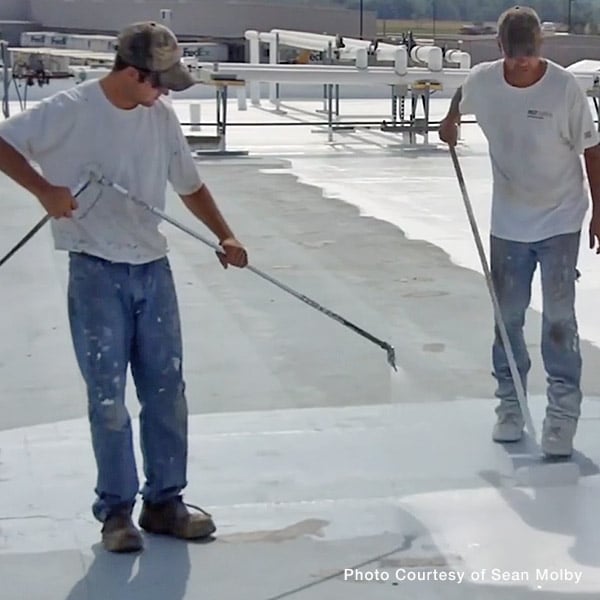
5. How resistant are rubber roofs to extreme weather?
Rubber roofs are highly resistant to extreme weather conditions, making them an ideal choice for areas with diverse climates. They can withstand significant temperature changes, high winds, heavy rain, and UV exposure without losing flexibility or integrity. Their resistance to water and wind damage makes them particularly well-suited for flat or low-slope commercial roofs, where drainage might be slower. Adding a reflective coating can further enhance their weather resistance, keeping the building better protected year-round.
6. What types of issues can rubber roof repairs address?
Rubber roof repairs can resolve various issues, including leaks, punctures, seam separation, blistering, and surface cracks. Over time, exposure to UV rays, heavy rain, and temperature fluctuations can cause damage that affects the roof’s waterproofing ability. Repairing these issues promptly restores the roof’s durability and helps prevent further problems. Addressing these common wear and tear issues not only preserves the rubber membrane but also helps reduce the need for more extensive repairs or premature replacement.
7. Can rubber roof repairs improve energy efficiency?
Yes, rubber roof repairs can significantly improve energy efficiency, especially when using reflective coatings. Coatings specifically designed for rubber roofs reflect up to 85% of UV rays, which can reduce roof surface temperatures by as much as 80°F. Lowering roof temperatures helps reduce cooling costs, making the building more energy-efficient. These energy savings are a key advantage of rubber roof repairs, as they contribute to a comfortable interior climate and support sustainability goals by lowering overall energy consumption.
5 Main Types of Commercial Rubber Roofs
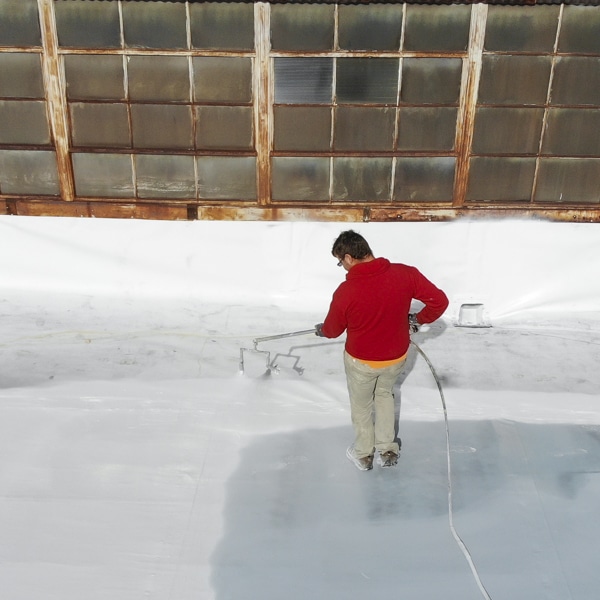
1. EPDM (Ethylene Propylene Diene Monomer)
EPDM is the most commonly used rubber roofing material, valued for its durability, flexibility, and affordability. Its large sheets are ideal for flat or low-slope roofs, minimizing seams and reducing potential leak points. EPDM is highly resistant to UV rays, weather, and temperature extremes. While typically black, EPDM can be treated with reflective coatings for energy savings. When damage occurs, rubber roof repairs for EPDM are straightforward and cost-effective, often involving patching seams or applying coatings that restore its waterproofing and extend its life.
2. TPO (Thermoplastic Olefin)
TPO, while technically a single-ply membrane, is often grouped with rubber roofs due to its similar flexibility. TPO is highly reflective, aiding energy efficiency by reducing cooling costs. Available in light colors, it’s ideal for warm climates. TPO is generally more resistant to punctures and mold than EPDM, though it may require regular inspections to maintain its integrity. Rubber roof repairs for TPO typically involve sealing seams and addressing punctures to retain its reflective properties and waterproofing abilities, especially if damaged by foot traffic or hail.
3. PVC (Polyvinyl Chloride)
PVC membranes, like TPO, offer flexibility and durability similar to rubber roofs. PVC is highly resistant to chemicals, grease, and fire, making it a top choice for commercial properties like restaurants, where chemical resistance is a priority. PVC also offers UV resistance and is available in reflective colors that enhance energy savings. Although rubber roof repairs for PVC are more specialized, they focus on maintaining the membrane’s durability in challenging environments, addressing issues like seam separation or small punctures without compromising its waterproof performance. These repairs help ensure long-term protection and prevent costly damage from spreading.
4. Modified Bitumen (Rubberized Asphalt)
Modified bitumen combines rubber or plastic polymers with asphalt for a strong, flexible roofing material. Its multiple layers, installed in rolls, provide excellent durability for low-slope roofs, though seams may require regular attention. While not identical to pure rubber roofs, its flexibility makes it a solid alternative for some buildings. Rubber roof repairs for modified bitumen typically involve reinforcing seams, repairing surface wear, and applying protective coatings to restore weather resistance and prevent leaks in high-traffic areas. Regular maintenance and timely repairs help preserve its performance and prevent moisture infiltration, ensuring the roof’s continued efficiency.
5. Butyl Rubber Roofing
Butyl rubber roofing is known for flexibility and resistance to UV rays and water. Its high waterproofing capabilities make it popular for applications beyond roofing, like pond liners, though less common for standard commercial roofing. Rubber roof repairs on butyl typically involve addressing punctures and applying fresh coatings to restore elasticity and waterproofing. Though installation and repairs can be more challenging than with EPDM, butyl’s longevity and resistance to weathering make it an option for demanding environments. Proper repairs maintain its performance, ensuring continued protection from the elements and minimizing the need for more extensive work in the future.
These roofing types each offer distinct strengths. EPDM remains a staple for flat commercial roofs, while TPO, PVC, and modified bitumen excel in areas with specific environmental or durability needs. Rubber roof repairs play a crucial role in maintaining and extending the life of each type, ensuring that they continue providing reliable protection.
Flat or Low-Slope Roofs
Rubber roofing is an excellent choice for flat or low-slope roofs due to its flexibility and ease of installation. EPDM membranes are available in large sheets, minimizing seams and reducing the risk of leaks. The material conforms well to irregular surfaces and edges, creating a watertight seal. Its lightweight nature means it doesn’t add significant structural load, making it suitable for retrofits and new constructions alike. Additionally, rubber roofing performs exceptionally well in draining water on low-slope surfaces, providing long-term durability and protection for commercial buildings that rely on efficient water management systems.
Buildings in Extreme Climates
EPDM rubber roofing is designed to withstand extreme weather conditions, making it ideal for buildings in both hot and cold climates. In cold regions, its flexibility allows it to expand and contract with temperature changes, preventing cracks and damage. The black surface option absorbs heat, melting snow and ice more effectively. For hotter climates, white EPDM reflects sunlight, reducing cooling costs and maintaining interior comfort. Its resistance to UV rays, ozone, and hail ensures reliable protection against environmental wear and tear, making it a durable and cost-effective roofing option in regions with fluctuating or severe weather patterns.
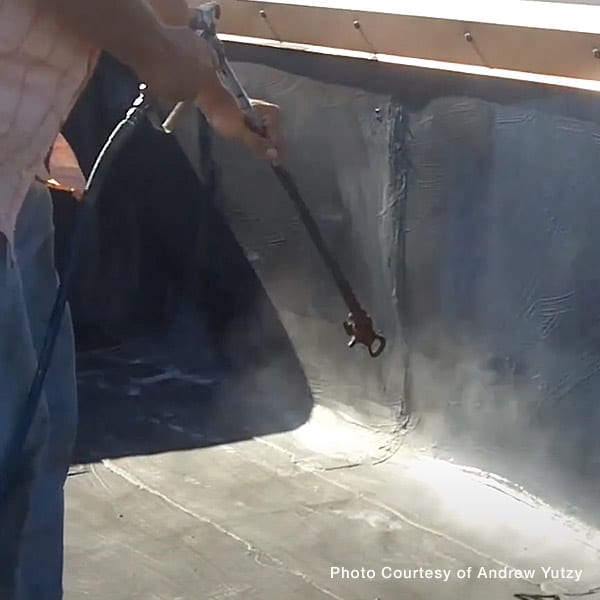
Cost-Sensitive Projects
For budget-conscious commercial projects, rubber roofing offers an excellent balance between affordability and performance. The material itself is cost-effective compared to other roofing options, and its lightweight design reduces labor and installation expenses. With minimal maintenance needs and an extended lifespan of 20-30 years or more, EPDM provides long-term savings. Easy repairability, through patch kits or roof coatings, further reduces costs for building owners. Whether for new constructions or roof replacements, EPDM’s durability and low cost make it an attractive option for businesses seeking reliable roofing solutions without compromising quality or exceeding budget constraints.
Maintenance Tips for Rubber Roofs
Regular Cleaning and Inspection
Keeping a rubber roof clean is essential for maintaining its longevity. Regularly remove debris like leaves, branches, and dirt that can accumulate and cause water pooling or punctures. Inspect the roof for signs of damage, such as tears, punctures, or loose seams. Pay attention to roof edges and areas around penetrations like vents or skylights. Conduct visual inspections after severe weather to catch potential issues early. Performing these simple checks every three to six months helps identify problems before they escalate into costly rubber roof repairs, ensuring the roof continues to protect your building effectively.
Scheduling Professional Inspections
While regular self-checks are valuable, professional inspections are necessary to detect issues you might miss. Schedule an expert evaluation at least once a year or after major weather events. Professionals use advanced tools and techniques to identify hidden problems, such as moisture trapped beneath the membrane or deteriorating adhesive bonds. They can also assess the roof’s overall condition and recommend necessary maintenance. Regular inspections not only prevent minor issues from becoming severe but also help extend the roof’s lifespan, saving money in the long run by avoiding premature replacement or expensive rubber roof repairs.
Applying EPDM Roof Coatings
EPDM roof coatings are a powerful way to restore and protect your rubber roof. These coatings create a seamless, waterproof barrier that enhances the membrane’s resistance to UV rays, weathering, and ponding water. Coatings also help repair minor cracks and imperfections, preventing further deterioration. By applying a coating every five to ten years, you can rejuvenate the roof’s surface and extend its lifespan significantly. This cost-effective solution improves energy efficiency by reflecting sunlight, reducing cooling costs, and keeping the roof in excellent condition, minimizing the need for costly rubber roof repairs in the future.
